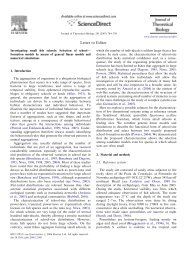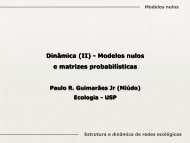SUPPLEMENTARY INFORMATION - Paulo R. Guimarães Jr.
SUPPLEMENTARY INFORMATION - Paulo R. Guimarães Jr.
SUPPLEMENTARY INFORMATION - Paulo R. Guimarães Jr.
You also want an ePaper? Increase the reach of your titles
YUMPU automatically turns print PDFs into web optimized ePapers that Google loves.
5956 <br />
different models of character evolution differs significantly from a star phylogeny (i.e.,<br />
no hierarchical structure). Branch-length transformation tests were performed assuming<br />
the Ornstein-Uhlenbeck model of stabilizing selection (OU) and a model in which<br />
character evolution can accelerate or decelerate (ACDC). Because ACDC models did<br />
not converge in most cases, we discuss results from the OU model (all analyses are<br />
included in Supplementary Database for completeness). Although the randomization<br />
method and the branch-transformation method provide similar information about the<br />
presence of a phylogenetic signal, applying both techniques can be useful to<br />
determining how robust our results are and to overcoming limitations inherent to each<br />
statistical test (below).<br />
COMPARING P-VALUES AND ESTIMATES OF PHYLOGENETIC SIGNAL<br />
It is not straightforward to perform comparisons between different trees and/or tip data<br />
(Blomberg et al. 2003), hence we adopted two different strategies to perform our<br />
comparisons. First, when we addressed whether the presence of phylogenetic signal was<br />
statistically significant, we employed phylogenies with branch lengths that were<br />
adequate according to diagnostics (in other words, branch lengths varied depending on<br />
the phylogeny and tip data; i.e., degree or species strength). Although the relationship<br />
between diagnostics and the randomization test is not clear, results from our database<br />
suggest that violations of traditional diagnostics can decrease the statistical power to<br />
detect phylogenetic signal (see also Table 1 in Rezende et al. 2004, and power analyses<br />
below). For instance, P-values obtained from randomization tests on 28 phylogenies,<br />
employing branch lengths which were adequate according to diagnostics, were<br />
significantly lower (paired t-test, t27 = 3.075, P = 0.005) than values obtained for the<br />
same phylogenies when all branch lengths were set equal to one (which violated<br />
diagnostics, see above). Accordingly, phylogenetic signal was significant (P < 0.05) in<br />
10 phylogenies, instead of 4, after branch lengths were appropriately transformed.<br />
Second, we compared K estimates (roughly the fraction of the amount of signal<br />
of the real data respect to the expectation assuming Brownian motion) obtained with<br />
species degree and strength employing the same phylogeny, with branch lengths set<br />
equal to one for all trees. Because our goal was to perform a pairwise comparison<br />
between K obtained with these different surrogates for species propensity to interact, we<br />
opted to employ the same branch lengths for species degree and strength to avoid<br />
confounding effects associated with different degrees of hierarchy on the starter





